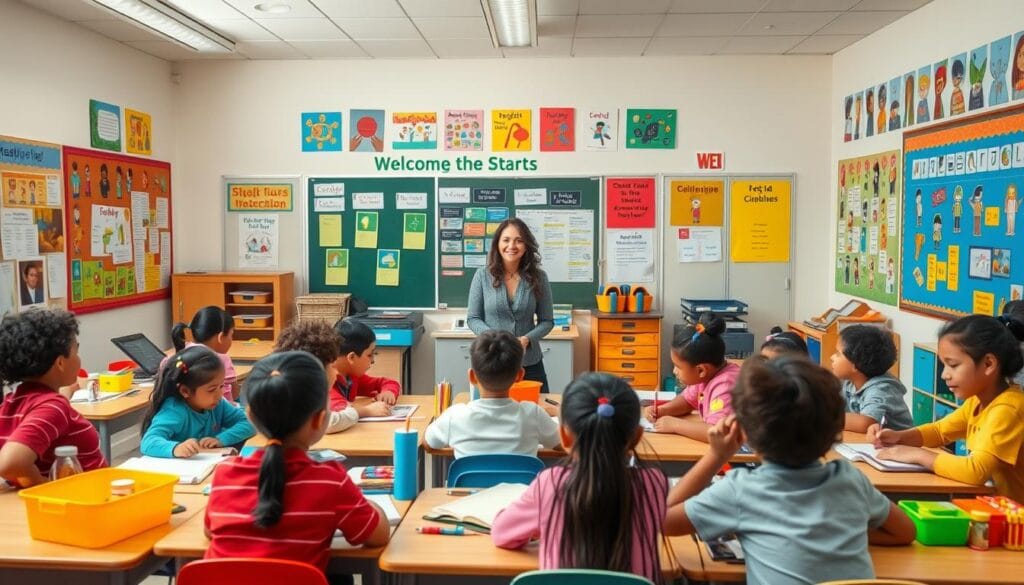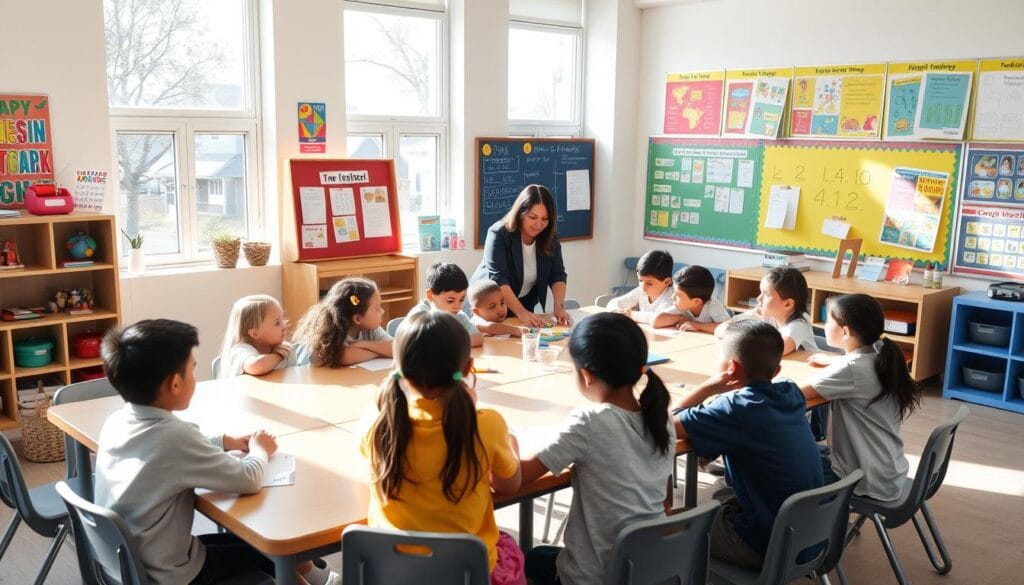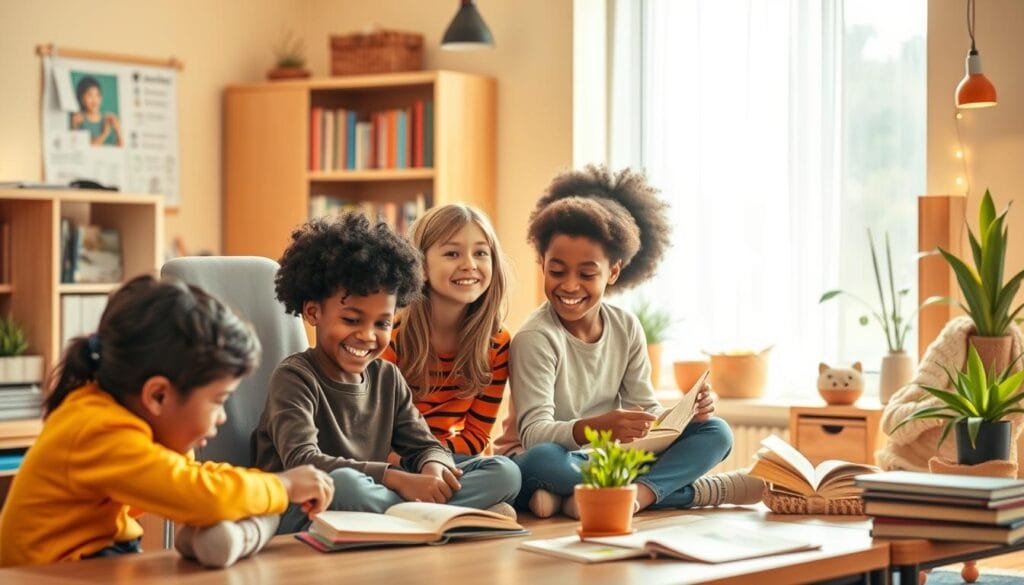Student Discipline Strategies: 9 Balanced and Effective Approaches
The debate on student discipline is ongoing in education. Traditional punishment is common, but new research points to a better way. It suggests a balanced approach could improve student behavior and create a better learning space.
Understanding modern discipline strategies is key. It’s important to know how punishment affects students and the value of positive reinforcement. By using research-backed methods, you can create a classroom that empowers students and builds a strong partnership with families.
فهرس المقالة
Understanding Modern Student Discipline Strategies
Student discipline has changed a lot, moving from old ways to new, research-backed methods. This change shows we now understand how punishment affects young minds.
Traditional vs. Contemporary Approaches
Old discipline methods included detention, suspension, and expulsion. These might have fixed problems for a while but didn’t really help students. Now, we focus on positive reinforcement, restorative practices, and trauma-informed approaches.
The Impact of Punishment on Student Development
Punishment can hurt a student’s feelings and motivation. It can make them feel left out and upset. It also can make problems like trauma worse, holding students back.
Research-Based Discipline Methods
New discipline methods aim to build strong relationships and make students feel part of the school. These methods, based on positive reinforcement, restorative practices, and trauma-informed care, work better. They help students behave better, do well in school, and feel good overall.
“Effective discipline is not about punishment; it’s about teaching, learning, and growth.” – Dr. Jane Doe, Education Researcher
By using these new discipline strategies, teachers can make schools better places. Students can then grow and succeed in the long run.
The Role of Positive Reinforcement in Student Behavior

Positive reinforcement is key in effective student discipline. It rewards good behavior instead of just punishing bad ones. This approach helps create a better learning space and teaches students important social skills.
Positive reinforcement motivates students to keep up good behavior. When they get praise for their efforts, they’re more likely to keep doing well. This leads to better grades, more classroom participation, and positive behavior changes.
- Positive reinforcement helps students understand what’s valued in class.
- It boosts their self-esteem and sense of accomplishment, aiding in social-emotional learning.
- It sets a good example for other students to follow.
Studies show positive reinforcement works well in schools. A study in the Journal of Positive Behavior Interventions found it reduced bad behavior and increased focus on learning. This shows why it’s vital for managing classroom behavior.
Using positive reinforcement in class involves many methods. These include praise, rewards, and special privileges. Teachers should make these strategies fit each student’s needs for them to be effective.
By using positive reinforcement, teachers can make learning a positive experience. Students will be more eager to learn and develop the skills they need for success.
Creating an Effective Classroom Management System
Good classroom management is key to successful student discipline. It starts with clear rules, regular routines, and a supportive place to learn. This way, teachers can stop problems before they start and make the classroom a fun place to be.
Setting Clear Expectations and Boundaries
Start by telling students what you expect from them. Explain the rules, what happens if they break them, and why. Make sure everyone knows the rules and stick to them. Let students help set the rules to make them feel more in charge.
Establishing Consistent Routines
Having set routines helps keep things calm and stops interruptions. Make a plan for when to move, listen, and do activities. Make sure students know and follow these plans. This makes the classroom feel safe and steady.
Building a Supportive Learning Environment
Make your classroom a welcoming, safe space for everyone. Encourage good relationships and a positive attitude towards learning. Give students a say in their learning to make them more excited about it.
Using these methods can help you manage your classroom well. It helps with behavior interventions and student discipline strategies. This makes the classroom a great place for everyone to learn.

Implementing Restorative Practices in Schools
A big change is happening in how schools handle discipline. Instead of just punishing, schools are now focusing on fixing problems and teaching social skills. This new way is called restorative practices and it’s changing how schools work.
Restorative practices believe in fixing problems by talking and working together. It’s not just about punishing students. It’s about teaching them to take responsibility and understand how their actions affect others.
The Benefits of Restorative Practices
Studies show that restorative practices really work. They help students behave better, make schools feel safer, and improve grades. Schools see fewer suspensions and better relationships between students and teachers.
- Promotes accountability and personal growth
- Fosters empathy and understanding between all stakeholders
- Encourages collaborative problem-solving and conflict resolution
- Enhances school climate and overall sense of community
- Supports social-emotional development and positive behavior
To start restorative practices, schools need to train teachers and set clear rules. They also need to build a culture of trust and respect. When done right, it can really change how schools handle problems.
“Restorative practices are not just about changing the way we discipline students, but about changing the way we think about discipline and our relationships with students altogether.”
| Traditional Discipline | Restorative Practices |
|---|---|
| Focus on punishment and consequences | Focus on accountability, empathy, and restoration |
| Isolation and exclusion of students | Inclusion and reintegration of students |
| Emphasis on rules and compliance | Emphasis on relationships and community |
| Limited student voice and participation | Active student involvement and decision-making |
Essential De-escalation Techniques for Educators
As educators, dealing with tough student behaviors is a delicate task. Learning how to calm down situations is key to a peaceful classroom. Knowing what triggers bad behavior helps you stop it before it gets worse.
Identifying Triggers and Warning Signs
Spotting early signs of trouble is the first step. Look for physical signs like fidgeting or clenched fists. Also, pay attention to changes in body language or voice tone. Knowing what each student is sensitive to helps you prevent problems.
Communication Strategies During Conflicts
When conflicts happen, how you talk matters a lot. Speak calmly and avoid harsh words. Listen to the student and show you understand their feelings. Give them choices and steer them towards better actions.
Post-incident Resolution Methods
After a problem, finding a good solution is crucial. Talk privately with the student to help them see their actions’ impact. Work together to find ways for better behavior in the future. Show them you’re there to help them succeed.
Learning these de-escalation skills helps make your classroom a place where everyone can learn and grow. Students will feel safe and able to handle their own actions.
| De-escalation Technique | Description | Key Benefits |
|---|---|---|
| Identify Triggers | Recognize early warning signs of student distress | Allows for proactive intervention and prevention |
| Calm Communication | Use a reassuring tone and avoid confrontational language | Helps de-escalate tense situations and promote resolution |
| Collaborative Resolution | Engage students in reflection and develop a plan for better behavior | Fosters student accountability and a sense of partnership |
“Effective de-escalation techniques empower educators to transform challenging situations into opportunities for growth and learning.”
Using these strategies in your classroom can make it a better place. It focuses on student well-being and supports good behavior. This improves how you manage the classroom.
Fostering Social-Emotional Learning Through Discipline
Traditionally, discipline in schools focused on punishment and following rules. But, research now shows that adding social-emotional learning (SEL) to discipline can be better. SEL teaches students to know themselves, control their actions, and work well with others. This helps them manage their behavior and form good relationships.
Positive reinforcement is a key part of SEL in discipline. Teachers use rewards for good behavior instead of just punishment. This makes students feel valued and encourages them to keep making good choices.
Restorative practices are also important. Instead of just punishing bad behavior, teachers help students see how their actions affect others. This teaches empathy, how to solve conflicts, and builds a sense of community in the classroom.

By mixing SEL into discipline, teachers create a supportive learning space. This approach helps students not just behave well but also succeed in school, socially, and emotionally.
- Integrate self-awareness and self-regulation activities into disciplinary practices
- Utilize positive reinforcement to encourage desired behaviors
- Implement restorative practices that promote empathy and community building
- Foster a learning environment that supports social-emotional development
“Discipline is not something done to students, but rather something done with them to help them develop the skills they need to be successful.”
Building Strong Parent-Teacher Partnerships for Discipline
Effective student discipline needs teamwork between parents and teachers. Strong partnerships help everyone work together. This unity benefits the student’s growth and development.
Effective Communication Channels
Good communication is key for a strong partnership. Set up regular meetings, progress reports, and ways to give feedback. Parents should feel free to share their thoughts on how to help their child.
Creating Unified Behavior Support Plans
- Work with parents to make a detailed plan for the student’s behavior.
- Make sure the plan has clear rules, consequences, and rewards for both home and school.
- Keep the plan up to date to handle new issues or changes.
Regular Progress Monitoring
Keep an eye on how well the discipline plans are working. Meet with parents often to talk about the student’s behavior. This teamwork keeps the discipline system strong and effective.
“By working together, parents and teachers can create a supportive and nurturing environment that fosters positive student behavior and academic success.”
When schools and families work together on discipline, it shows students they matter. This partnership leads to better results for students.
Trauma-Informed Approaches to Student Behavior
As educators, it’s key to understand how trauma affects student behavior. Trauma-informed methods see challenging behaviors as signs of emotional or psychological wounds, not just lack of discipline. These strategies help create a supportive and caring classroom for students.
Students who have faced trauma, like abuse or violence, can struggle in school. Their behaviors might be disruptive or withdrawn. Trauma-informed methods aim to tackle these issues at their source, not just punish them.
Creating a safe classroom is a big part of trauma-informed teaching. It means setting clear rules and offering emotional support. This helps students feel safe and builds trust, allowing them to cope better.
It’s also vital to offer specific help and support. This might include working with mental health experts or teaching social skills. By addressing the reasons behind student behavior, you help them grow stronger and more self-assured.
In the end, trauma-informed teaching focuses on empathy and support, not punishment. By using these methods, you make your classroom a place where students can thrive and reach their goals.
| Conventional Approach | Trauma-Informed Approach |
|---|---|
| Focuses on punishment and consequences | Emphasizes understanding and support |
| Treats behavior problems as intentional | Recognizes behavior as a response to trauma |
| Aims to control and modify student behavior | Seeks to create a safe and nurturing environment |
| Isolates and removes students from the classroom | Integrates students and provides targeted interventions |
“Trauma-informed approaches recognize that many challenging behaviors may stem from unresolved emotional or psychological wounds, rather than simply a lack of discipline.”
By using trauma-informed student discipline strategies and behavior interventions, you can make your classroom a better place for everyone. This helps students overcome their challenges and achieve their dreams.
Developing Equitable Disciplinary Policies
Creating fair disciplinary policies is key to a supportive school environment. Teachers must work to remove bias and understand different cultures when handling student behavior.
Eliminating Bias in Discipline Practices
Our unconscious biases can affect how we discipline students unfairly. Schools need to review their policies, find biases, and fix them to ensure fairness.
Cultural Competency in Behavior Management
It’s important to know about our students’ diverse backgrounds. This knowledge helps teachers manage behavior in a way that respects everyone’s unique needs.
Alternative Intervention Strategies
Traditional punishment doesn’t solve the real problems of misbehavior. Schools should try new ways like restorative practices and social-emotional learning. These focus on growth, empathy, and responsibility.
| Discipline Approach | Key Characteristics | Outcomes |
|---|---|---|
| Punitive Discipline | – Focus on punishment – Exclusionary practices (suspensions, expulsions) | – Increased student disengagement – Widening achievement gaps – Negative impact on student well-being |
| Equitable Discipline Policies | – Emphasis on prevention and intervention – Restorative practices – Culturally responsive approaches | – Improved school climate – Enhanced student-teacher relationships – Increased academic and social-emotional outcomes |
By focusing on fairness, understanding cultures, and using new strategies, schools can create a better place for learning. This leads to better grades and happier students.
Conclusion
Effective student discipline strategies go beyond old ways of punishment. By using positive reinforcement, restorative practices, and social-emotional learning, you can help students grow. This approach makes the classroom a place where everyone can thrive.
It’s important to keep improving your discipline methods. This means using the latest research and best practices. You should set clear rules, have consistent routines, and create a supportive space. This way, students feel they can control their actions.
Creating a good classroom management system is a continuous effort. Stay updated, work with parents and the community, and use trauma-informed methods. This helps make disciplinary policies fair for all students. Together, we can build a future where discipline is based on empathy and the full development of each child.
FAQ
What are the key differences between traditional and contemporary approaches to student discipline?
Traditional methods often use punishment like detention and expulsion. Today, we focus on positive actions and understanding why students act out. This new way aims to create a supportive place for learning.
How can positive reinforcement be effectively implemented in the classroom?
Positive reinforcement rewards good behavior. It uses praise, small rewards, and makes learning fun. This builds a positive classroom culture.
What are the essential elements of an effective classroom management system?
A good system has clear rules, routines, and a supportive atmosphere. It stops problems before they start and encourages good behavior.
How can restorative practices improve student behavior and school culture?
Restorative practices fix harm and solve problems together. They focus on fixing relationships and teaching empathy. This leads to better school climates and fewer problems.
What are some key de-escalation techniques educators can use to address disruptive behaviors?
Teachers can use calm talk and strategies to help students calm down. This keeps the classroom safe and focused.
How can social-emotional learning (SEL) be integrated into disciplinary practices?
SEL teaches students to manage their feelings and get along with others. It helps them behave better and do well in school.
What are the benefits of strong parent-teacher partnerships in supporting student discipline?
Working together, parents and teachers can support students better. They share information and work on plans together. This helps students succeed.
How can a trauma-informed approach enhance student discipline strategies?
This approach understands that some behaviors come from past trauma. It creates a caring environment where students can learn to cope and manage their feelings.
What are the key elements of equitable disciplinary policies in schools?
Fair policies avoid bias and teach educators about different cultures. They use new ways to help students, not just punish them. This ensures everyone is treated fairly.






